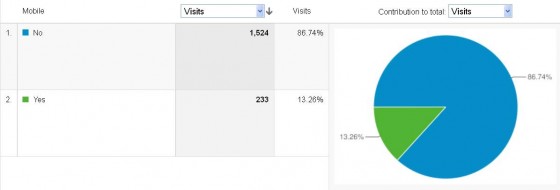 Google recently announced that the Googlebot-Mobile crawler now crawls with a smartphone user-agent. This is a part of Google’s continued efforts to provide better and better results for people browsing the web specifically on their smartphone — a demographic that is increasing exponentially, even within the industrial market, as our White Paper on the topic showed.
Google recently announced that the Googlebot-Mobile crawler now crawls with a smartphone user-agent. This is a part of Google’s continued efforts to provide better and better results for people browsing the web specifically on their smartphone — a demographic that is increasing exponentially, even within the industrial market, as our White Paper on the topic showed.
Another feature rolling out from Google with this new user agent is something they’re calling Skip Redirect for Smartphone. Right now if you’re using a smartphone to browse the web and you go to a website that has a mobile-optimized version, the site will redirect your phone to the mobile-optimized version. Now Google will skip that step for you: if you are conducting a search from a smartphone and Google sees that the site has a mobile version, the link that appears in the search results will take you directly to the mobile version — which saves you time and has the effect of loading the site faster.
What’s Next for Google Mobile?
This is just the latest push Google has made to create a better experience for smartphone users. Google is predicting heavily that smartphones are going to continue their exponential usage climb and wants to continue to dominate mobile search — a market that they already have a 98% share in thanks to their early mobile strategy — by providing the best possible search experience.
This is the cornerstone of Google’s business model: by providing the best search experience they’ll get the largest market share, which means they can put their ads in front of more people, and make more money.
The next likely move for Google is going to be considering whether or not a site has a mobile version as a ranking factor for searchers with mobile phones. In other words, if your site has a mobile-optimized version, people searching for keywords from a smartphone will see your site rank higher in the search results. This is a logical progression of Google’s mobile-focus for smartphones that would result in a better experience for smartphone users.
Should You Act Now?
Not every site really needs a mobile version — it all depends on your particular industry. At Ecreative we work with a lot of clients that still receive less than 3% of their visits from mobile devices, and for most of those clients the impact of building a mobile version of the site is probably not worth the cost — there are likely places that the marketing money could be better spent to yield a greater impact.

As a general unscientific rule of thumb I like to say that once 10% of your traffic comes from mobile agents, it’s time to have a mobile-optimized version of your site. But of course it’s not really that simple; here’s the right way to figure it out:
Find out what it would cost to build a mobile version of your site, and determine how many users that would impact. Right now there isn’t any good research about the exact impact that a mobile version has to your bottom line, other than we know it improves sales and conversions (just like speeding up site load time and usability always does). But then look at that budget and try to figure out whether you could create a similar improvement for more users for the same money by doing something else.
Sites that haven’t invested much in their site and online marketing will often find that there is lower-hanging fruit where they can get more bang for their buck. Similarly companies that have already invested well in their internet marketing efforts will likely find that launching a mobile-version of their site will have a much better impact that the smaller gains that they can currently get from putting more effort on social media or SEO rankings.
But when examining the amount of smartphone traffic your site receives, don’t just look at the last couple of months. Be sure to see how that mobile traffic has been trending over the course of the last year — be sure that you’re aware of how your mobile share is growing so you can make logical predictions of where it is likely to be over the course of the next year. Mobile growth rates are different from site to site and industry to industry, but all of them are growing.






